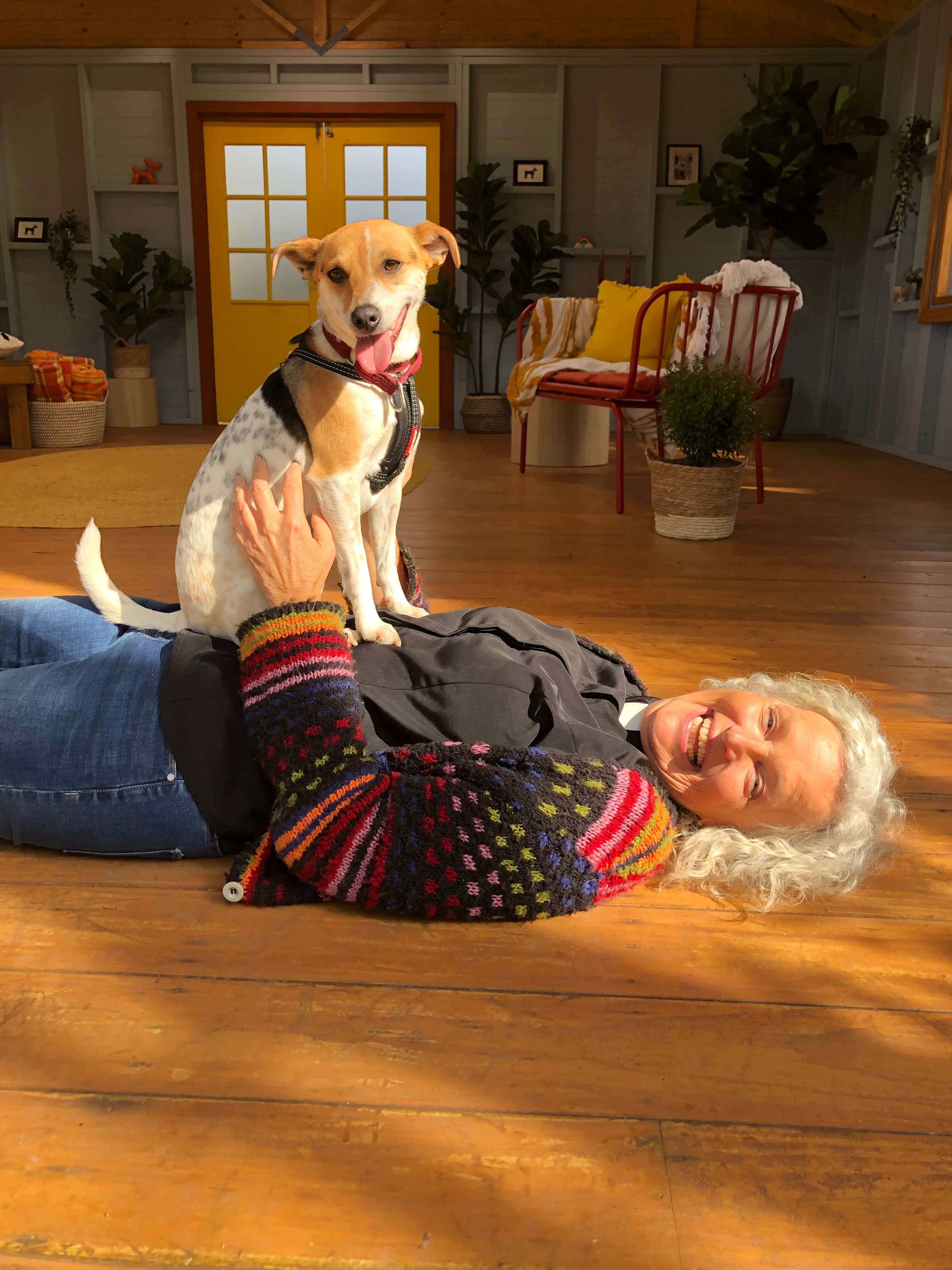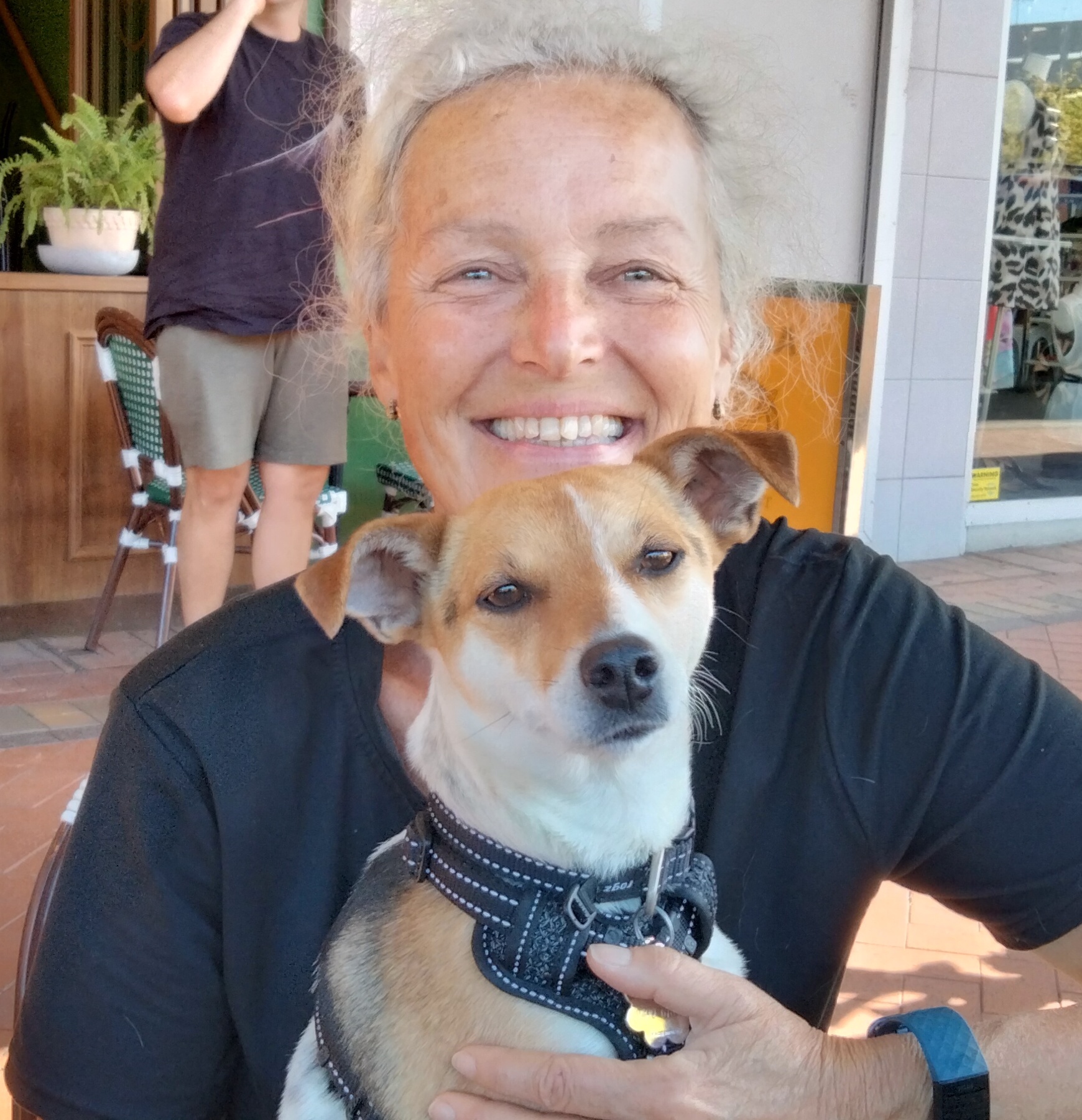Missy and Me: Reflections on a friendship
Wednesday, 10 May 2023
| Claire Louise Wright

I found Missy the day I lost my dad.
I met her at the Animal Welfare League shelter in Kemps Creek; fell in love; signed adoption papers; arranged foster care; and drove away – feeling more elated and more bereft than I could possibly have imagined – to return to my dad’s palliative care. I showed him a photo of Missy, sharing the trepidations and joys of the day. And as we said goodnight, for what turned out to be the last time, he said: ‘I’m glad you’re going to be happy with a doggy, when you go home…’.
I gazed at Missy’s picture often, in the days that followed.
I still wonder, sometimes, whether I rescued Missy – or she rescued me.
***
I had never lived with an animal. Our childhood cat was misanthropic – and I, allergic – so the possibilities for mutual affection were pretty limited. I’d got on fine with friends’ dogs, though, and had always thought I’d eventually ‘get one’. As an introverted hermit in a socially demanding vocation, I was strongly attracted to the idea of uncomplicated, non-verbal companionship. Nevertheless, it felt like a big decision. I knew that sharing my personal space and ‘down' time with another creature would be challenging. And could I even offer a dog a ‘good home’? At minimum, that seemed to require base-line financial security, time, some kind of routine and possibly a back yard – and I never seemed to have all those ducks in a row.
I was always attracted to the (literally ‘redemptive’) idea of rescuing. I worried, of course, that I wouldn’t be able to care adequately for a dog with health or behavioural issues, but the ethical arguments were compelling. How could I participate in a system bringing ever more puppies into the world, when shelters were overflowing with ‘unwanted’ animals needing homes? Our faith calls us to have a preferential care for the lost, least and left behind – and it seemed to me a failure of imagination to apply that any less to dogs than to people.
It also became clear that, even had I wanted to go through a breeder, I would never have been able to pick a breed! Whenever I successfully ruled out a ‘type’ of dog on the basis of generic characteristics, I would invariably meet an individual whom I found completely delightful. So when I was offered the chance to have a dog chosen for me by the match-makers at the AWL – I leaped.
***
Some things are like the Tardis from Dr Who: much bigger on the inside than they look from the outside. The life of faith is one such thing. Living with a dog is another.
I’d anticipated some aspects, of course. (I had, you know, bought a lint roller.) But I didn’t anticipate – how could I? – how genuinely life-changing it would be, bonding with a creature of another species.
A dog is – beyond a useful prompt to work-life balance – a compelling invitation to Sabbath. As Andrew Root insightfully notes: ‘they need to be walked, brushed and cuddled, and their need is grace to us’ (The Grace of Dogs, 2017, 101). Dogs have mastered the art of simply being; of resting when rest is required. ‘Just watching an animal closely can take you out of your mind and bring you into the present moment’, writes Eckart Tolle, ‘which is where the animal lives all the time – surrendered to life’. (Guardians of Being, 2009, 32).
Like any microcosm of the creation that reflects its Creator, a dog is also an unfailing source of wonder, a prompt to theological reflection – and a mirror held up to humanity. Ask any dog person what the ‘fruit of the Spirit’ looks like, and they will invariably be able to tell you what each quality looks like – in their dog… Dogs love unconditionally, forgive unreservedly, play uninhibitedly and fulfil their vocation by being always and authentically themselves. Reflecting on Missy’s being, and our life together, is a daily spiritual practice, offering irresistible pictures, parables and provocations.
She also exercises (better than I can, I suspect, on my best day) a beautiful ministry of presence in our community: emanating essential goodness; accepting all comers with unconditional positive regard; and holding space for grief and need and hope, with her quiet gaze and offered warmth. She has the dog’s peculiar gift for making connections – not only with other dogs and people, but between people. (There is startlingly little small talk when we meet in a dog’s orbit: within moments, we are sharing experiences of grace and gratitude, loneliness and consolation, healing and meaning. Galilean-lakeside, Emmaus Road-type conversations. Conversations that communities of faith would love to be having with their neighbours, but quite possibly aren’t….)
Call it ‘missy-ology’.
***
‘Consider the birds of the air’, Jesus once said – inviting us into just such a contemplation of what the non-human creation can teach us of God’s delight and care, God’s value for all God has made. I wonder how often we do, in fact, attend to, reflect on and take seriously these other living beings that share our world; with whom, in the ancient poetic imagination of our faith, we share no less than an original blessing (Genesis 1:22, 28), a divine covenant (Genesis 9:9-10), a call to worship (Psalm 148:7-12) and a destined shalom (Isaiah 11:6-9); and for whom we are meant to be custodians and carers (Genesis 2:5). The works of Andrew Linzey, among others, unflinchingly confront us with how far we are from both Eden and Paradise…
When a video snippet of Missy and me went viral on social media – did I mention that we met on a reality TV show? – all the comments were celebratory. Except one. ‘I feel sorry for this dog,’ it said, ‘in a toxic religious environment which has never understood other species’. The video showed Missy leaping onto my lap; me murmuring ‘Would you like me to be your human?’; and her turning round to lick my chin. But still…
In Bible Study, many years ago, my friend Kevin asked for prayer for his beloved dog who was dying, and was told: ‘Animals don’t have souls; we don’t pray for them’. This seemed to me, even then, a profoundly inadequate response – to the anguished human, if not to the suffering creature. (‘I would not give much for that man’s religion’, as Abraham Lincoln once said, ‘whose dog is not the better for it’.) But animal theology is still deeply contested. Is a dog, in fact, capable of love – as opposed to exhibiting behaviours developed through millennia of co-evolution to elicit food? Is there any sense in which a dog’s life, or a dog-human relationship, might have a spiritual dimension, as Nobel Prize-winning zoologist Konrad Lorenz seemed to suggest?
It may sound naïve and trite, but anyone who has looked deeply into the eyes of a dog would answer ‘Of course!’ Even my secular-materialist brother, having met Missy’s serious brown gaze for a while, observed: ‘There’s definitely something going on in there.’
***
There is definitely something going on in there. And since there is neither scientific framework nor religious consensus around what ‘soul’ is, it seems arrogantly anthropocentric to assert that humans ‘have one’ and animals don’t – mainly because we have (in some eras and cultures) tended to prioritise rationality as the measure of both soul and salvation.
There is, however, provocative theological work emerging (Stephen H. Webb, On God and Dogs, 1998; Andrew Root, The Grace of Dogs, 2017) on how our emotional bonds with companion animals might inform how we think about animals in general. On how they are both a gift to us, and give to us, creating a reciprocal obligation that enables relationships of genuine mutuality. On how the element of ‘excess’ in these relationships – a self-giving beyond any utilitarian calculation – places them firmly in the category of gift, or grace (or as the meme has it: ‘We don’t deserve dogs’.) On how dogs, in particular, have evolved innate capacities for empathy, bonding and play that are foundational in human spirituality.
Ask me if Missy has a soul, though, and I will simply invite you to look her in the eye. Emmanuel Levinas argued that spirit or soul is experienced in a need for connection – to know and be known – which is offered supremely in the face of another being. The rich tradition of contemplating icons depends on this experience of gazing on something that gazes back; of gazing on something through which God gazes back, in what Martin Buber called an ‘I-Thou’ encounter, irreducible subjectivity to irreducible subjectivity. ‘Every being is a spark of the Divine or God’, writes Ekhart Tolle. ‘Look into the eyes of the dog and sense that innermost core’ (Guardians of Being, 2009, 104).
Dogs seem uniquely able to meet us ‘I-to-I’; to attend and attune and attribute meaning to human faces and gestures. Research suggests they do this more than any other creature, more with humans than with other dogs, and innately, from puppyhood (Brian Hare and Venessa Woods, The Genius of Dogs, 2013). It’s a mystery and a gift. And I’m sure we could explain it away or de-spiritualise it if we wanted to. But some things are like the Tardis from Dr Who: much bigger on the inside than they look from the outside. The life of faith is one such thing. Gazing deeply into the eyes of a dog is another.
Claire Louise Wright is an ordained minister serving as a community chaplain in regional New South Wales. Missy is a three-year old Jack Russell / Fox Terrier cross.

Image credits: Claire Louise Wright and Missy.